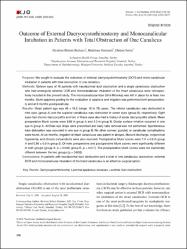| dc.contributor.author | Buttanrı, İbrahim Bülent | |
| dc.contributor.author | Buttanrı, Bahtınur | |
| dc.contributor.author | Serin, Didem | |
| dc.date.accessioned | 2020-03-23T12:56:48Z | |
| dc.date.available | 2020-03-23T12:56:48Z | |
| dc.date.issued | 2019 | en_US |
| dc.identifier.citation | Buttanrı, İ. B., Buttanrı, B. ve Serin, D. (2019). Outcome of external dacryocystorhinostomy and monocanalicular intubation in patients with total obstruction of one canalicus. Korean Journal of Ophthalmology, 33(2), 138-141. http://doi.org/10.3341/kjo.2018.0077 | en_US |
| dc.identifier.uri | http://doi.org/10.3341/kjo.2018.0077 | |
| dc.identifier.uri | https://hdl.handle.net/20.500.12511/5079 | |
| dc.description.abstract | PURPOSE: We sought to evaluate the outcomes of external dacryocystorhinostomy (DCR) and mono-canalicular intubation in patients with total obstruction of one canalicus. METHODS: Sixteen eyes of 16 patients with nasolacrimal duct obstruction and a single canaliculus obstruction who had undergone external DCR and monocanalicular intubation of the intact canaliculus were retrospectively included in the present study. The monocanalicular tube (Mini Monoka) was left in place for at least two months. Munk epiphora grading for the evaluation of epiphora and irrigation was performed both preoperatively and at 6 months postoperatively. RESULTS: Mean patient age was 46 ± 14.2 (range, 18 to 76) years. The inferior canaliculus was obstructed in nine eyes (group A) and the superior canaliculus was obstructed in seven eyes (group B), respectively. Eight eyes had chronic dacryocystitis and two of these eyes also had a history of acute dacryocystitis attack. Mean preoperative Munk scores were 3.89 in group A and 4.0 in group B. Ocular surface irritation occurred in one eye in group A. Artificial eye drops were prescribed and early tube removal was not performed. Spontaneous tube dislocation was recorded in one eye in group B. No other corneal, punctal, or canalicular complications were found. At six months, irrigation of intact canaliculus was patent in all eyes. Mucoid discharge, conjunctival hyperemia, and chronic conjunctivitis were also resolved. Postoperative Munk scores were 1.11 ± 0.9 in group A and 0.86 ± 0.9 in group B. Of note, preoperative and postoperative Munk scores were significantly different in both groups (group A, p = 0.006; group B, p = 0.017). The postoperative Munk scores were not statistically different between the two groups (p = 0.606). CONCLUSIONS: In patients with nasolacrimal duct obstruction and a total of one canaliculus obstruction, external DCR and monocanalicular intubation of the intact canaliculus is an effective surgical option. | en_US |
| dc.language.iso | eng | en_US |
| dc.rights | info:eu-repo/semantics/openAccess | en_US |
| dc.rights | Attribution-NonCommercial 3.0 Unported | * |
| dc.rights.uri | https://creativecommons.org/licenses/by-nc/3.0/ | * |
| dc.subject | Dacryocystorhinostomy | en_US |
| dc.subject | Lacrimal Apparatus Diseases | en_US |
| dc.subject | Lacrimal Duct Obstruction | en_US |
| dc.title | Outcome of external dacryocystorhinostomy and monocanalicular intubation in patients with total obstruction of one canalicus | en_US |
| dc.type | article | en_US |
| dc.relation.ispartof | Korean Journal of Ophthalmology | en_US |
| dc.department | İstanbul Medipol Üniversitesi, Tıp Fakültesi, Cerrahi Tıp Bilimleri Bölümü, Göz Hastalıkları Ana Bilim Dalı | en_US |
| dc.identifier.volume | 33 | en_US |
| dc.identifier.issue | 2 | en_US |
| dc.identifier.startpage | 138 | en_US |
| dc.identifier.endpage | 141 | en_US |
| dc.relation.publicationcategory | Makale - Uluslararası Hakemli Dergi - Kurum Öğretim Elemanı | en_US |
| dc.identifier.doi | 10.3341/kjo.2018.0077 | en_US |



















